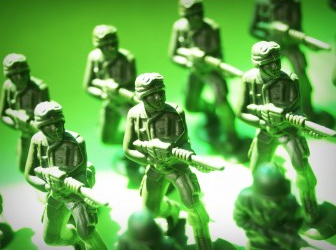Waste plastic becomes 3D printed filament! The US military is also used to repair equipment parts.
HC Plastics News: According to foreign media Recycling International, the US Army Research Laboratory has invented a method to convert post-consumer plastic into 3D printed materials. This allows trained soldiers to quickly repair replacement parts for military vehicles, weapons and equipment. Researchers at the US Army Research Laboratory (ARL) have fabricated composite thermoplastic filaments using a method called solid-state shear pulverisation. In this process, shredded waste, mainly plastic bottles, and some paper and cardboard, are comminuted in a twin-screw extruder to produce fines. These powders are then melt processed into 3D printed filaments. The mechanical properties of the new 3D printed filaments have improved and their average strength is 70 MPa, making them useful materials for the maintenance of military trucks, weapons and other important tools. The US Army Research Laboratory has discovered a way to convert post-consumer plastic into 3D printed materials. This allows trained veterans to quickly create replacement parts for military vehicles, weapons and equipment. Reduce waiting time Most military bases in the United States have 3D printers. US Marine Corps captain Anthony Molnar said that military bases sometimes have to wait a month to refill the printed filaments. He said that the transformation of this waste plastic into 3D printed filaments is expected to change this wait. ARL researcher Dr. Nicole Zander said that ideally, soldiers do not have to wait for the next supply car to receive important equipment. She explained that now they can basically enter the cafeteria, collect discarded water bottles, milk cans, cardboard boxes and other recyclable items, and then use these materials as raw materials for 3D printers to make tools, parts and other gadgets. Act quickly "Now, our opponents' tactics and equipment are updated very fast," Captain Morner said. "This new technology will enable fighters to beat ever-changing enemy technology faster." The US Marine Corps and research experts are now collaborating to build a mobile recycling trailer for specially trained soldiers to make 3D printed filaments from plastic waste. Dr. Zander pointed out: "How to best process these materials, and which additives can improve their performance, we still have a lot to learn. We are just trying to solve the problem of these waste plastics." Editor in charge: Yao Chunlin
Solar
water heating system is a cost-effective system for residential hot water application. This system is designed according to thermosiphon principle and operating with
proportion difference between cold and hot water. The water heated by vacuum
tubes is held in the stainless steel storage tank where the insulation
preserves the heat.
The
thermosiphon Solar Water Heater uses the sun to heat the working fluid (mostly
water) in the Vacuum Tubes. The Solar Collector absorbs solar radiation, and
converts the sunlight to heat and transfer it to the water. The heated water
naturally rises through the solar collector into the water tank where the
cooler water at the bottom of the tank is forced out and descends to the bottom
of the collector (thermosiphon circulation). The circulation will be
interrupted when there is no solar radiation.
Solar Panel Hot Water System,Thermal Hot Water System,Thermal Water Heater System,Solar Power Heating System Linuo Ritter International Co.,Ltd , https://www.lnrtsolarenergy.com
